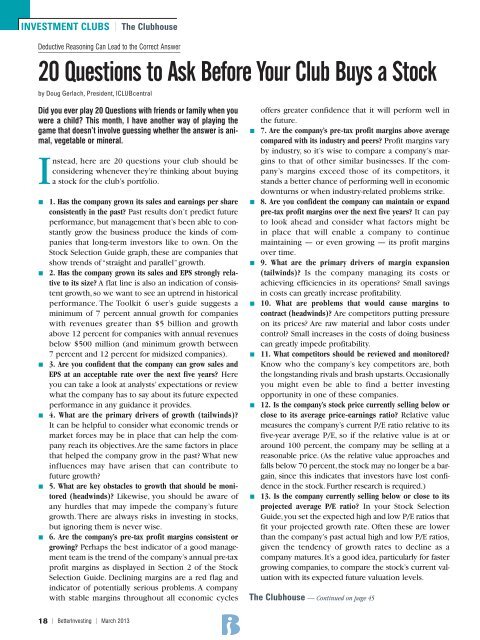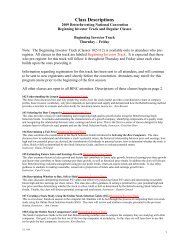STOCK TO STUDY: T. Rowe Price Group, Inc ... - BetterInvesting
STOCK TO STUDY: T. Rowe Price Group, Inc ... - BetterInvesting
STOCK TO STUDY: T. Rowe Price Group, Inc ... - BetterInvesting
Create successful ePaper yourself
Turn your PDF publications into a flip-book with our unique Google optimized e-Paper software.
INVESTMENT CLUBS | The Clubhouse<br />
Deductive Reasoning Can Lead to the Correct Answer<br />
20 Questions to Ask Before Your Club Buys a Stock<br />
by Doug Gerlach, President, ICLUBcentral<br />
Did you ever play 20 Questions with friends or family when you<br />
were a child? This month, I have another way of playing the<br />
game that doesn’t involve guessing whether the answer is animal,<br />
vegetable or mineral.<br />
Instead, here are 20 questions your club should be<br />
considering whenever they’re thinking about buying<br />
a stock for the club’s portfolio.<br />
■<br />
■<br />
■<br />
■<br />
■<br />
■<br />
1. Has the company grown its sales and earnings per share<br />
consistently in the past? Past results don’t predict future<br />
performance, but management that’s been able to constantly<br />
grow the business produce the kinds of com -<br />
panies that long-term investors like to own. On the<br />
Stock Selection Guide graph, these are companies that<br />
show trends of “straight and parallel” growth.<br />
2. Has the company grown its sales and EPS strongly relative<br />
to its size? A flat line is also an indication of consistent<br />
growth, so we want to see an uptrend in historical<br />
performance. The Toolkit 6 user’s guide suggests a<br />
minimum of 7 percent annual growth for companies<br />
with revenues greater than $5 billion and growth<br />
above 12 percent for companies with annual revenues<br />
below $500 million (and minimum growth between<br />
7 percent and 12 percent for midsized companies).<br />
3. Are you confident that the company can grow sales and<br />
EPS at an acceptable rate over the next five years? Here<br />
you can take a look at analysts’ expectations or review<br />
what the company has to say about its future expected<br />
performance in any guidance it provides.<br />
4. What are the primary drivers of growth (tailwinds)?<br />
It can be helpful to consider what economic trends or<br />
market forces may be in place that can help the com -<br />
pany reach its objectives. Are the same factors in place<br />
that helped the company grow in the past? What new<br />
influences may have arisen that can contribute to<br />
future growth?<br />
5. What are key obstacles to growth that should be monitored<br />
(headwinds)? Likewise, you should be aware of<br />
any hurdles that may impede the company’s future<br />
growth. There are always risks in investing in stocks,<br />
but ignoring them is never wise.<br />
6. Are the company’s pre-tax profit margins consistent or<br />
growing? Perhaps the best indicator of a good management<br />
team is the trend of the company’s annual pre-tax<br />
profit margins as displayed in Section 2 of the Stock<br />
Selection Guide. Declining margins are a red flag and<br />
indicator of potentially serious problems. A company<br />
with stable margins throughout all economic cycles<br />
■<br />
■<br />
■<br />
■<br />
■<br />
■<br />
■<br />
offers greater confidence that it will perform well in<br />
the future.<br />
7. Are the company’s pre-tax profit margins above average<br />
compared with its industry and peers? Profit margins vary<br />
by industry, so it’s wise to compare a company’s margins<br />
to that of other similar businesses. If the com -<br />
pany’s margins exceed those of its competitors, it<br />
stands a better chance of performing well in economic<br />
downturns or when industry-related problems strike.<br />
8. Are you confident the company can maintain or expand<br />
pre-tax profit margins over the next five years? It can pay<br />
to look ahead and consider what factors might be<br />
in place that will enable a company to continue<br />
main taining — or even growing — its profit margins<br />
over time.<br />
9. What are the primary drivers of margin expansion<br />
(tailwinds)? Is the company managing its costs or<br />
achieving efficiencies in its operations? Small savings<br />
in costs can greatly increase profitability.<br />
10. What are problems that would cause margins to<br />
contract (headwinds)? Are competitors putting pressure<br />
on its prices? Are raw material and labor costs under<br />
control? Small increases in the costs of doing business<br />
can greatly impede profitability.<br />
11. What competitors should be reviewed and monitored?<br />
Know who the company’s key competitors are, both<br />
the longstanding rivals and brash upstarts. Occasionally<br />
you might even be able to find a better investing<br />
opportunity in one of these companies.<br />
12. Is the company’s stock price currently selling below or<br />
close to its average price-earnings ratio? Relative value<br />
measures the company’s current P/E ratio relative to its<br />
five-year average P/E, so if the relative value is at or<br />
around 100 percent, the company may be selling at a<br />
reasonable price. (As the relative value approaches and<br />
falls below 70 percent, the stock may no longer be a bargain,<br />
since this indicates that investors have lost confidence<br />
in the stock. Further research is required.)<br />
13. Is the company currently selling below or close to its<br />
projected average P/E ratio? In your Stock Selection<br />
Guide, you set the expected high and low P/E ratios that<br />
fit your projected growth rate. Often these are lower<br />
than the company’s past actual high and low P/E ratios,<br />
given the tendency of growth rates to decline as a<br />
company matures. It’s a good idea, par ticularly for faster<br />
growing companies, to compare the stock’s current valuation<br />
with its expected future valu ation levels.<br />
The Clubhouse — Continued on page 45<br />
18 | <strong>BetterInvesting</strong> | March 2013





